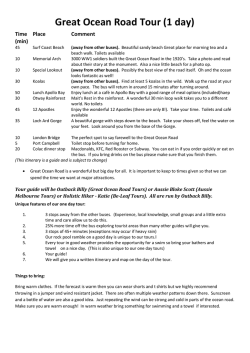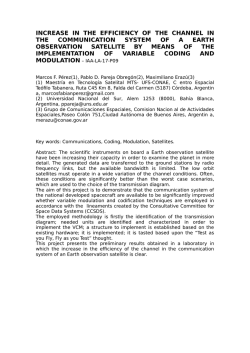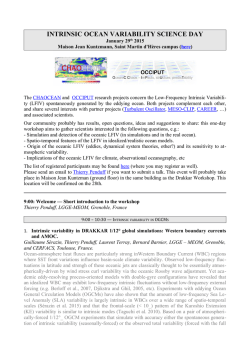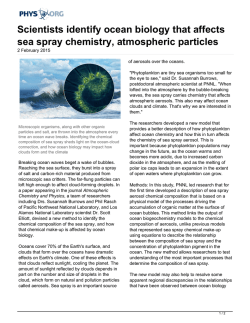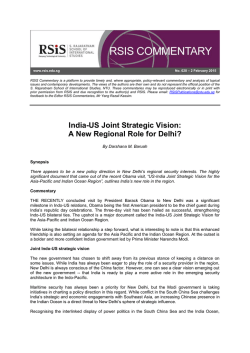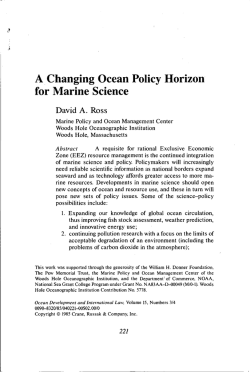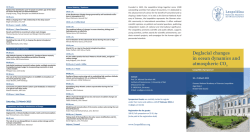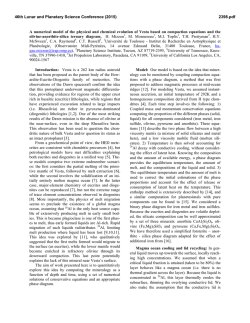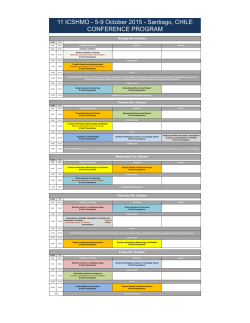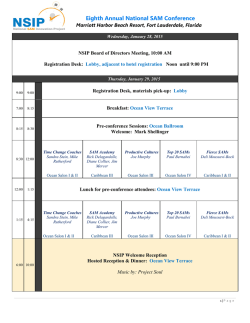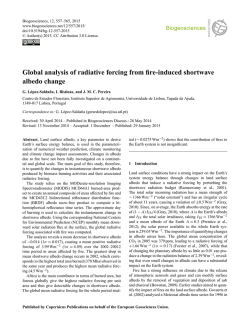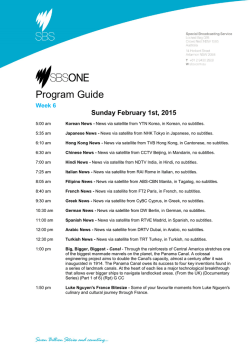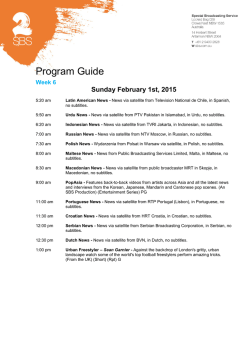
SUMMARY Background
SUMMARY Background The vastness, hostile and turbulent nature of oceans has created problems in making in-situ observations over them. This has resulted in lack of information over the oceans that cover 70% of the total globe. Oceans play major role in climate change through various air-sea interaction mechanisms and therefore it is very important to collect observations over oceanic regions. With the advent of various satellite missions like NOAA, TOPEX/POSEIDON, INSAT, ERS, QUIKSCAT, TRMM and Jason, during last two decades, a lot of surface information over the global oceans have started to pour in. However, gaps in subsurface observations remain unfulfilled even after the deployment of Argo floats. Ocean General Circulation Models (OGCMs) play a very important role in providing this information. OGCMs themselves depend upon many factors that affect the simulated output. Surface boundary forcing parameters like winds and heat fluxes are some of these factors. The availability of these parameters from satellites has motivated us to use them in OGCMs and report their impact either through assimilation or directly as forcing. The present study has made use of observations from satellite and demonstrates its impact in simulating the variability of thermodynamic structure of the Indian Ocean on different spatial and temporal scales. Objectives of the Thesis Major objectives that are addressed in this study are as follows: • Study the impact of satellite data, through assimilation and as forcing, on Ocean General Circulation Model (OGCM) simulations. structure) using (thermodynamic the best possible generation state Ocean • 1% Ik % combination of model physics and forcing data sets. • Study the variability of the thermodynamic structure of Indian Ocean on different spatial and temporal scales from the ocean state prepared by OGCM. 0 i A step-by step approach to achieve these objectives is presented in detail in the thesis, which is divided in six major chapters. Chapter wise summary of the work is as follows: 9 « Chapter-1 deals with the background and spirit behind the present study. The chapter highlights the need for an OGCM for ocean process studies. Importance of data assimilation and the existing techniques have been discussed in this chapter. Ocean model, which is mainly forced from the atmosphere-ocean % interface, is sensitive to surface forcing hence its sensitivity to these forcing has been discussed. Importance of satellites in numerical ocean modeling has been highlighted. The chapter discusses the scope of the present study. The importance of the study in context of upcoming Indian satellite missions is also discussed. 9 Chapter-2 gives the description of the OGCM used in the study. The model is based on Modular Ocean Model -version 3 (MOM-3) acquired from Geophysical Fluid Dynamics Laboratory (GFDL), National Ocean Atmosphere Administration (NOAA). Details of the underlying principles and assumptions on which model physics is based and the fundamental equations used in the model are given in this chapter. The chapter discusses the model grid structure, domain and various boundary conditions used during the study. Before performing any experiment using an OGCM, a control run (also known as spin-up) of the model is required. Since MOM-3 is a highly versatile code with many parameterizations schemes f available for its physics and dynamic component, some experiments for selection for the vertical mixing schemes, for example, have been performed during the control run and region wise comparison with available climatology has been made to figure out which combination suits best for different regions. The chapter * also discusses the modifications needed in the model to account for various airsea interaction processes. Chapter-3 focuses on the impact of satellite data assimilation in numerical ocean model. The original code from GFDL is modified to take into account major physical and biological processes like the inclusion of bulk formulae for latent and sensible heat flux computations, parameterization of penetration of shortwave radiation, etc. The study period is 1997-2004. Hence it is desired to have the model initialized to conditions of 1997. The initialization process involves integration of the model for 1992-1996. The results for 1996 are compared with observations (mainly in terms of SST). There are large differences especially in the equatorial regions. In order to improve the initial conditions for 1997 and also to find the sources of errors in the model, the technique of data assimilation has been used. SST from NOAAA/AVHRR is assimilated in the model for the year 1996. The control run (without assimilation) and the assimilated runs are compared with observations. Assimilation of SST makes lot of improvements, particularly in the equatorial Indian Ocean (IO). An estimate of net heat flux correction (through assimilation) required to bring the model closer to the observations is made. The chapter also discusses the various factors that are responsible for errors in SST simulations. Chapter-4 discusses the ocean model sensitivity to surface boundary forcing. These sources are either the atmospheric general circulation model's (AGCMs) output or the satellite derived products. The chapter discusses the impact of three major surface boundary forcing (the surface wind stress, the surface heat fluxes and the absorption coefficients that attenuate the solar radiation) on the basic model output parameters like temperature, current profiles and sea level anomaly and also on the derived parameters like the 20 deg isotherm depth. Details of experiments performed using different forcing fields are given. The 9 •• t t objective of this chapter is two fold, one to find the best possible combination of r » surface boundary forcing to generate the near-accurate ocean state and secondly to study the impact of satellite data in forcing the ocean models. It is found that the OGCM when forced with satellite derived winds is able to capture the ocean variability and more so sub-surface variability consistent with the __ • observations and has definite advantage over the winds obtained from NCEP. However, SST simulated using satellite winds are found to have larger Root * Mean Square Error (~1-2°C). The possible reason for this contrast is discussed. Furthermore, in this chapter the role of solar radiation in the generation of intraseasonal oscillations in SST is also addressed. The experiments indicate that there is a large discrepancy in the SST simulations when net shortwave radiation estimates from atmospheric model is used. It is found that the satellite derived % solar radiation, when used to force the OGCM, simulates the intra-seasonal oscillations in SST realistically. The chapter also shows the impact of satellite derived solar radiation attenuation coefficients on the ocean model simulations. It is found that the inclusion of satellite derived attenuation coefficients alter upper ocean simulations, particularly the mixed layer depth quite significantly. At the end of this chapter the best possible combination of surface forcing that resulted from various experiments has been summarized. Using the above combination an ocean state for the period 1997-2004 is prepared and sample results are compared with observations. The ocean state prepared is found to be consistent with observations and can be used to study the variability in oceanic parameters. The model deficiencies are also discussed. Chapter-5 This chapter discusses the Indian Ocean thermodynamic variability at various temporal scales as obtained from the OGCM. The annual mean § behavior and seasonal variability of temperature, currents and 20 deg isotherms from model is discussed. The 8-year period simulation (1997-2004) consisted of an important inter-annual event called the Indian Ocean Dipole (IOD). The model could faithfully simulate this event. The chapter discusses the changes in the 3-D * * 4 m m m % * % % % structure of the Indian Ocean in terms of SST, sub-surface temperature, depth of 20° isotherm, currents and salinity, during this event. It is found that there is an % % advance sub-surface signature of the dipole mode at least 2-3 months prior to when it appears on the surface. This is most likely to provide insight into the % formation and decay of IOD. Although IOD is confined to equatorial Indian Ocean, it is found that the circulation pattern in Bay of Bengal reversed during this event. There were associated changes in the dynamics of the South Eastern Arabian Sea (SEAS) during this event. The variability of the Indonesian Throughflow (ITF) is also discussed. The final section of this chapter describes the intra-seasonal variability of SST. The model performs well in simulating the % % variability on intra-seasonal scale as well. Not only the 30-60 day but also oscillations of low periods (8-16 days) have been very well simulated by the % model. The possible mechanism behind these oscillations in the Bay of Bengal (BOB) has been discussed. It is found that these low period variabilities have a close linkage with atmospheric convective activity. Chapter-6 summarizes the entire study and the major findings of the work done. The major conclusion and consensus that comes out from the study is the usefulness of the satellite data in OGCM simulations on inter-annual and intraseasonal scales. However, the satellite data needs to be in balance with the other forcing parameters. The chapter also discusses the model limitation in salinity and sub-surface current simulations. Among the surface boundary forcing the fresh water flux play an important role in salinity and sea level anomaly variability. These fluxes need to be prescribed accurately in-order to improve model simulations. Assimilation of surface salinity from future satellite missions can improve the salinity simulations and even can help in tuning the model parameters for further improvements. The chapter finally ends giving emphasis on the need of having an Ocean atmosphere coupled model for taking into account the air-sea interaction processes in a more realistic manner. %
© Copyright 2025
